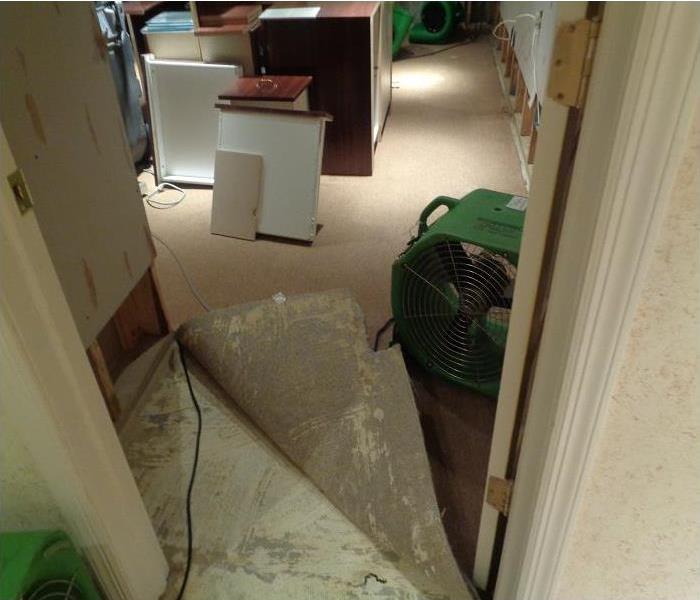Recent Mold Remediation Posts
Tips to detect Mold
6/7/2018 (Permalink)
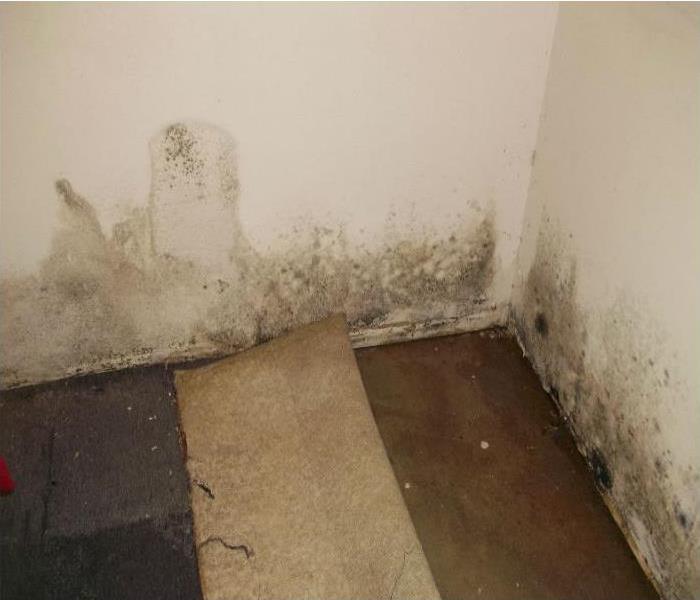 Mold found in drywall.
Mold found in drywall.
If there are ongoing moisture problems in your home or building it is important to be alert for presence of visible mold, strong musty odors which may indicate mold is present, or any evidence of past moisture problems that might have caused mold growth. If you see any of the following signs below contact a certified mold testing company.
- Mold smell
- Visible mold grown
- Water leaks, water instruction or past flooding.
Mold can be found behind walls, in the basement, under carpet, in damp areas of the house, surrounding roof leaks or in area that experiences high humidity.
The only way to accurately assess the amount of mold in your home is to test for it. The three main types of test for mold are:
- Air Testing
- Surface Testing
- Bulk Testing
Contact your local SERVPRO to have the pleasure to assist and guide you to asset the problem before it spreads to other areas.
6 Steps to Prevent Carpet Mold After Water Damage
6/5/2018 (Permalink)
Reprinted by angieslist.com
The best way to keep mold from spreading is to act fast when you know water is present.
1. Remove water as quickly as possibleUse a wet/dry vacuum to clean up as much water as soon as possible. These machines are the most effective tools for removing water and can be rented or provided by water damage remediation companies that specialize in repairing residential flood damage.2. Use fans to speed up carpet drying process
It can take several days for fans to completely dry a water-damaged area. The good news is that they also help circulate fresh air.
3. Use a dehumidfier to dry out the room
These machines remove excessive moisture, which makes the air feel cooler and limits mold and mildew growth. Any equipment that helps dry out the air and the ground will speed up the drying time for your damaged floors and coverings.
4. Steam clean carpet and flooring
Steam clean all carpets to properly sanitize and deodorize. Typically, water-damaged carpet padding must be replaced.
Replacing just the padding is much less expensive than having to re-carpet your entire home.
5. Sanitize walls and baseboards
Anything touched by storm water should be sanitized. Clean all walls, hard-surface floors and other household surfaces.
6. Check furniture
Look for water damage and remove furniture from wet flooring.
Water damage can easily be hidden underneath rugs or carpet, so be sure to give your home a thorough inspection if you suspect water damage.
Cleaning water-soaked carpets and floors is difficult under any conditions, but in the aftermath of a storm or flood, contamination by mud, silt, sewage and mildew, can compound the problem. The Institute for Inspection Cleaning and Restoration Certification recommends that in such cases, a certified mold restoration service provider should evaluate water damage and remove mold.
Mold Stains Successfully Removed With a Cleaning By SERVPRO of Great Neck/Port Washington
5/25/2018 (Permalink)
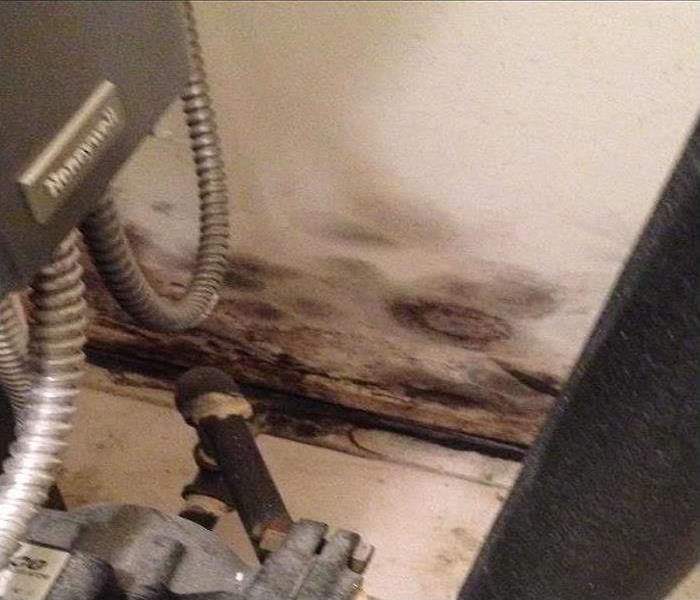 You don't have to live with mold - call SERVPRO of Great Neck/Port Washington
You don't have to live with mold - call SERVPRO of Great Neck/Port Washington
Often when homeowners try to clean mold on their own, they are left with unsightly black mold stains on wood and other materials - they have changed the stain, and often made it worse. Frequently out of despair, they will splash around straight or diluted bleach that quite often creates even more damage and is a hazard. Bleach does not kill off mold, that is a false rumor that has managed to perpetuate itself. It is not true but there is a hope and a better way!
When you call in SERVPRO of Great Neck/Port Washington, your job is handled by trained professionals who are using the most effective products and equipment available. Our mold treatments have amazing results! Don't lose property value because mold is growing or staining wood and drywall - we can help. We can stop the mold and banish the staining.
We have seen consistently amazing results with our restorations products and techniques - which is why SERVPRO has grown to over 1700 locations, nationwide! Insurers love us as restoration usually cost a lot less than replacing, we are expert at restoration and cleanup after fire, water or even mold events - so remember our name.
Tips for Mold Prevention
5/24/2018 (Permalink)
Best way to prevent mold growth in your place is by controlling the moisture. Put in practice these advice can help you to prevent mold growth.
- Keep indoor humidity levels low. (Ideally between 30% - 50%)
- Using fans can help with ventilation, also can improve and control indoor air quality.
- Try to keep the laundry room and kitchen area vented to the outdoors when possible.
- During humid seasons try to reduce moisture buildup using an air conditioner or air dehumidifier.
- Water problems, leaks or other structures that lead to moisture buildup, should be identified and repairs as son as possible to prevent further damage to the interior of your home or business. Thus, keeping low humidity levels will persevere your ceilings, walls and floors.
keep in mind controlling moisture is the key to preventing mold growth.
Manhasset, NY Mold Removal and Remediation | SERVPRO of Great Neck/Port Washington
5/24/2018 (Permalink)
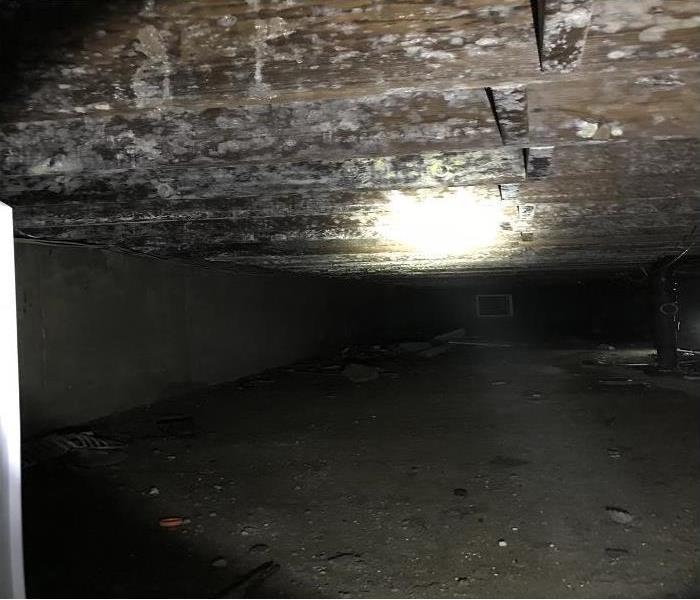 Mold started in the attic and was ignored until it progressed to lower floors - don't ignore the signs!
Mold started in the attic and was ignored until it progressed to lower floors - don't ignore the signs!
Mold can produce allergens and irritants and has the potential to cause other health effects. Mold can spread quickly through your Manhasset, New York home or business in as little as 48 hours. If you suspect that your home or business has a mold problem from what you see or by odors that won't go away, give our office a call before it progresses any further.
If mold is found, we have the training equipment, and expertise to remediate. Depending the extent of mold found on an initial visual inspection, it may be necessary to have environmental testing done by an independent environmental hygienist. If so, we then follow their protocol for the remediation.
It's important to be attentive when mold is suspected as it can continue to grow and damage your property. Learn more about mold and what to do until help arrives by reviewing these mold damage tips. SERVPRO of Great Neck/Port Washington has a crew professionally trained to help in situations involving mold.
Hidden Water Lurking Under Your Kitchen Counters
5/24/2018 (Permalink)
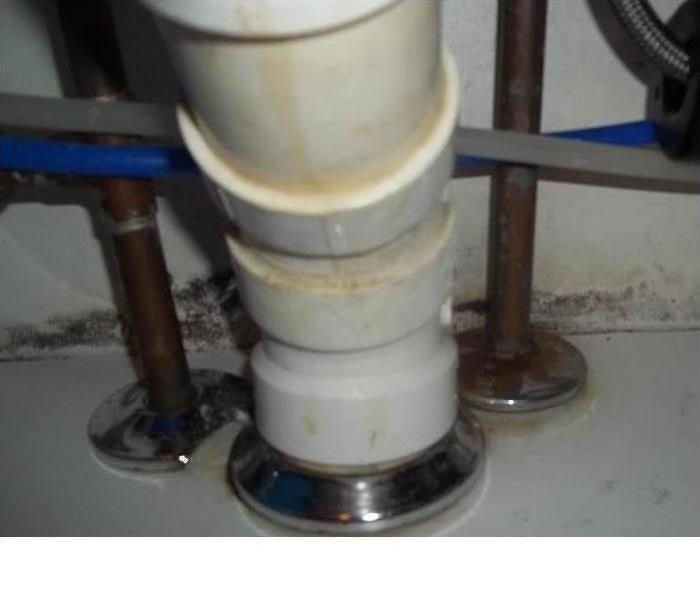 Mold damage under a sink in a Long Island, NY kitchen
Mold damage under a sink in a Long Island, NY kitchen
The area under the kitchen sink and the dishwasher are often the ones we see on jobs! They conceal water problems as they aren't out in the open and may be obscured by pots and pan, dishes and dry goods. But when they leak, if the situation is not corrected quickly, things can progress and mold can start to grow.
This kitchen sink pipe had a leak that did subsequently result in mold growth, so SERVPRO of Great Neck/Port Washington was called in to remediate. We are trained and certified for Mold in New York State, and have antimicrobials and cleaning techniques that can resolve the problem and prevent any further growth. We make it "Like it never even happened." Think you have a mold problem here on Long Island? Give us a call! 516-767-9600
SERVPRO of Great Neck/Port Washington to conduct 3-Credit Insurance Mold
4/18/2017 (Permalink)
 CE Class Understanding Mold for Property Insurers
CE Class Understanding Mold for Property Insurers
SERVPRO of Great Neck/Port Washington is hosting a free 3-credit New York Continuing Education Course for Insurance Professionals with NYS Insurance Licences BR, PC & C3.
Mold is a big concern that directly affects the insurance community and involves third-party liability issues for property owners, builders, sellers, related service industries & institutions.
The course will be held in Syosset, at a lecture theater courtesy of our event partner, EisnerAmper - accountants & advisors.
SERVPRO of Great Neck/Port Washington's course comes with a light breakfast, available in the lobby between 8:15am-8:30am.
Preregistration is required - seats are limited. Please email barbara@SERVPROofgreatneck.com for the online registration link and details.
Mold is a Hidden Hazard
2/16/2017 (Permalink)
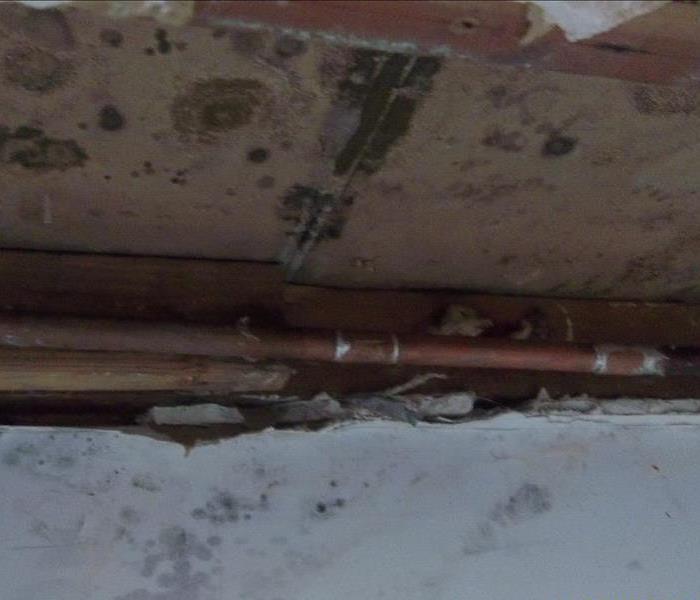 mold - Great Neck, NY
mold - Great Neck, NY
Mold grows as a result of humidity, presence of mold spores (that occur and exist naturally) and a food source of organic material.
In this home, mold was present in dark and hard to see areas but the effects were noticeable for the homeowners. They called SERVPRO of Great Neck/Port Washington to come and do mold remediation and we were able to successfully remove all the contaminated and affected materials, and bring the readings down to normal levels through our SERVPRO protocols that involve cleaning not only the materials and structure but filtering the air as well, removing both mold and moisture.
When the remediation is done, independent environmental testing will show that the remediation was successful.
If you suspect you have mold, give us a call at 516-767-9600.
Is There Mold Lurking Behind Your Filing Cabinets?
1/27/2017 (Permalink)
 Mold lurking behind filing cabinets.
Mold lurking behind filing cabinets.
We get mold calls on a daily basis - Long Island is a humid environment, from the eastern most tip of Suffolk County to the west- Nassau County, Brooklyn, Queens and Staten Island. When your building gets damp and the conditions and humidity are right you can have mold growth.
Mold can permanently damage documents and books, clothing, furnishings, and personal effects - and can cause health effects for humans and animals. Left unabated, it will continue to spread and destroy things. Bleach and other remedies may remove discoloration but do not kill the live mold - what you thought you removed will return.
At SERVPRO of Great Neck/Port Washington, we have been trained and certified by the IICRC in Mold. We follow protocol in mold remediation and use anti-microbial agents that will destroy the mold. Call us at 516-767-9600
Does Your Long Island Home or Business Have A Mold Problem?
5/20/2016 (Permalink)
 On Long Island, New York, mold can spread through a building in as little as 48 hours.
On Long Island, New York, mold can spread through a building in as little as 48 hours.
Microscopic mold spores naturally occur almost everywhere, both outdoors and indoors. This makes it impossible to remove all mold from a home or business. Therefore, mold remediation reduces the mold spore count back to its natural or baseline level. Some restoration businesses advertise “mold removal” and even guarantee to remove all mold, which is a fallacy. Consider the following mold facts:
- Mold is present almost everywhere, indoors and outdoors.
- Mold spores are microscopic and float along in the air and may enter your home through windows, doors, or AC/heating systems or even hitch a ride indoors on your clothing or a pet.
- Mold spores thrive on moisture. Mold spores can quickly grow into colonies when exposed to water. These colonies may produce allergens and irritants.
- Before mold remediation can begin, any sources of water or moisture must be addressed. Otherwise, the mold may return.
- Mold often produces a strong, musty odor and can lead you to possible mold problem areas.
- Even higher-than-normal indoor humidity can support mold growth. Keep indoor humidity below 45 percent.
If your home or business has a mold problem, SERVPRO of Great Neck/Port Washington can inspect and assess your property and use our specialized training, equipment, and expertise to remediate your mold infestation.
If You See Signs of Mold, Call Us Today – 516-767-9600
NY Lawmakers Approve Mold Licensing Bill
7/15/2014 (Permalink)
Originally published by Indoor Environment Connections
The New York Legislature has approved legislation that would require the licensure of mold inspection, assessment and remediation specialists and sets minimum work standards for mold inspection, assessment and remediation specialists.
The bill, which has bipartisan support, aims to ensure that only properly trained, licensed professionals can conduct mold assessment, abatement and remediation services.
Applicants for the license must have completed state-approved course work, including training on the appropriate use and care of personal protection equipment as approved by the commissioner of New York’s Department of Health.
If the bill becomes law, an applicant for a license to perform mold remediation will have to submit a financial statement, prepared by an independent auditor or accountant, stating the assets of the applicant. This will be used to determine the financial responsibility of the applicant to perform mold remediation services.
Applicants would also have to submit insurance certificates showing workers' compensation coverage, if required, and liability insurance of at least $50,000.
“A major obstacle to rebuilding after Superstorm Sandy has been the widespread cases of mold affecting Nassau County homes and businesses,” said Assemblyman Harvey Weisenberg, the bill’s sponsor. “Mold removal can be expensive, and it’s important that it’s done right, as it poses a serious public health risk. This bill would require that mold remediation specialists are licensed and qualified to make sure mold is properly removed.”
Mold can cause serious health risks, especially for children and those suffering from asthma. This legislation ensures that only licensed professionals, who have undergone an extensive licensing process, are able to provide mold-related services. “It prevents unscrupulous contractors from taking advantage of those in need, both now and in the future,” Weisenberg said.
“Superstorm Sandy devastated our communities, destroying more than 70,000 homes and businesses in Nassau County,” said Assemblyman Weisenberg. “This legislation will help families move forward because even though we’ve endured great struggles over the past two years, together we can safely re-build our homes.”
The bill has been sent to Gov. Andrew Cuomo for approval. A spokeswoman for the governor said he has not yet declared publicly if he will sign it.
Mold in Rentals: Landlord Liability, Responsibility, and Prevention
6/18/2014 (Permalink)
Excerpted from an article by Janet Portman, Attorney for NOLO
Mold is one of the newest environmental hazards causing concern among renters. Across the country, tenants have won multimillion-dollar cases against landlords for significant health problems — such as rashes, chronic fatigue, nausea, cognitive losses, hemorrhaging, and asthma — allegedly caused by exposure to “toxic molds” in their building.
If you suspect there is mold in your rental unit, learn what to look for and when your landlord might be liable. Even better, take steps to prevent mold before it becomes a problem—or clean mold up before it does become a problem.
Where Mold Is Found
Mold comes in various colors and shapes. The villains — with names like stachybotrys, penicillium, aspergilus, paecilomyces, and fusarium — are black, white, green, or gray. Some are powdery, others shiny. Some molds look and smell disgusting; others are barely seen — hidden between walls, under floors and ceilings, or in less accessible spots, such as basements and attics.
Mold often grows on water-soaked materials, such as wall paneling, paint, fabric, ceiling tiles, newspapers, or cardboard boxes. Humidity sets up prime growing conditions for mold. Buildings in naturally humid climates of Texas, California, and the Southern U.S. have experienced more mold problems than residences in drier climates. But whatever the climate, mold can grow as long as moisture is present.
Mold and Your Health
Mold is also among the most controversial of environmental hazards. There is considerable debate within the scientific and medical communities about which molds, and what situations, pose serious health risks to people in their homes. There is no debate, however, among tenants who have suffered the consequences of living amidst (and inhaling) mold spores.
Keep in mind, however, that most mold is not harmful to your health — for example, the mold that grows on shower tiles is not dangerous. It takes an expert to know whether a particular mold is harmful or just annoying. And it’s very tricky to find out whether a person who has been exposed to mold has actually inhaled or ingested it. New tests that measure the presence of a particular mold’s DNA in a blood sample are the only way to know for sure whether the mold is present in the body.
Landlord Legal Responsibilities for Tenant Exposure to Mold
With a few exceptions, landlord responsibilities regarding mold have not been clearly spelled out in building codes, ordinances, statutes, or regulations. Below is a discussion of the few states and cities that do have mold laws, and an explanation of how landlords can be held responsible for mold problems even absent specific laws governing mold.
Federal Law on Mold
No federal law sets permissible exposure limits or building tolerance standards for mold in residential buildings.
State Laws on Mold
Only a few states have taken steps toward establishing permissible mold standards. California, Indiana, Maryland, New Jersey, and Texas are among the few that have passed laws aimed at developing guidelines and regulations for mold in indoor air.
For example, California’s “Toxic Mold Protection Act of 2001″ authorizes the state’s Department of Health Services (now called the Department of Health Care Services) to set permissible levels of indoor mold exposure for sensitive populations (like children, or people with compromised immune systems or respiratory problems). The California law also allows the DHCS to develop identification and remediation standards for contractors, owners, and landlords and requires landlords to disclose to current and prospective tenants the presence of any known or suspected mold.
Local Laws on Mold
A few cities have enacted ordinances related to mold. For example:
New York City. Landlords in New York City must follow Department of Health guidelines for indoor air quality.San Francisco. In San Francisco, mold is considered a legal nuisance, putting it into the same category as trash accumulation or an infestation of vermin. Tenants (and local health inspectors) can sue landlords under private and public nuisance laws if they fail to clean up serious problems.Where to Find Information on Mold-Related Laws
For information on mold rules and regulations in your state check with your state department of environmental protection (find yours at the federal EPA website) or your state department of public health (the Centers for Disease Control and Prevention has a list).
To see whether your state is considering mold-related legislation that might affect residential rentals, see the website of the National Conference of State Legislatures and type “mold” into the search box on the home page. Look for the link to the “Environmental Health Legislation Databases Guide,” and once there, filter by “All States” and “Indoor Air Quality—Mold.”
For local mold-related rules, contact your city manager or mayor’s office or local health department. Check out State and Local Government on the Net (www.statelocalgov.net) for finding local governments online.
Mold and the Landlord’s Duty to Maintain Habitable Premises
Even if your state or city doesn’t have specific mold laws, your landlord may still be liable for a mold problem in your rental. Here’s an overview of the issues;
Mold Caused by a Landlord’s Failure to Fix Leaks
Landlords in all states but Arkansas are responsible for maintaining fit and habitable housing and repairing rental property, and this extends to fixing leaking pipes, windows, and roofs — the causes of most molds. If the landlord doesn’t take care of leaks and mold grows as a result, you may be able to hold the landlord responsible if you can convince a judge or jury that the mold has caused a health problem.
Mold Caused by Tenant Behavior
The liability picture changes when mold grows as the result of your own behavior, such as keeping the apartment tightly shut, creating high humidity, or failing to maintain necessary cleanliness. When a tenant’s own negligence is the sole cause of injury, the landlord is not liable.
Mold Clauses in Leases
Some landlords include clauses in the lease that purport to relieve them from any liability resulting from mold growth. At least one court (in Tennessee) has refused to enforce such a clause, ruling that to do so would be against public policy. More cases from other parts of the country are sure to arise as mold litigation makes its way through the courts.
A smart landlord will try to prevent the conditions that lead to the growth of mold — and tenants should be the landlord’s partner in this effort. This approach requires maintaining the structural integrity of the property (the roof, plumbing, and windows), which is the landlord’s job. You can help by preventing mold problems in your home in the first place and promptly reporting problems that need the landlord’s attention.
Summer: Humidity & Mold
6/16/2014 (Permalink)
Originally posted by GeneralAire 4/14/2014
During summer months, temperatures and humidity rise; increasing your chances for mold growth. It is estimated that 10% of the U.S. Population is sensitive to mold and experience allergic reactions, asthma attacks and sinus infections (American College of Allergy, Asthma and Immunology).
The good news: mold can be prevented. The key is moisture control.
Preventing Mold
• Clean moisture spills immediately. Repair leaks. Clean up water damage immediately, as mold starts growing within 24-48 hours.
• Control humidity. Dehumidifiers keep humidity low by removing excess moisture from your home's air. While there are room dehumidifiers, whole home dehumidifiers protect your whole house vs just one room. Humidity below 50% prevents mold growth. Place your dehumidifier:
- in your basement
- in a crawl space
Detecting Mold
• Mold grows in dark, damp spaces. It's commonly found in basements, bathrooms, and crawl spaces. The color can be green, black, blue, orange or purple.
• Be aware mold can also grow in hidden areas, such as behind wall paper, above ceiling tiles and inside cabinets where plumbing fixures are found.
• If you detect mold, take action immediately to remove it and prevent future growth.
Removing and Cleaning Mold
• Clean and remove visible mold with an EPA-registered mold and mildew disinfectant (Moldex disinfectant, Anabec, and BacShield are examples). Bleach is found not to be as effective, as mold spores can re-grow after treatment with bleach.
• If you see mold on drywall, you must remove and replace the drywall.
• If you see what you consider wide-spread mold or suspect it is toxic, contact a mold remediation professional. Toxic mold produces dangerous toxins that can cause neurological symptoms and even death.
• Protect yourself while cleaning the mold with gloves, a face mask and possibly goggles.




 24/7 Emergency Service
24/7 Emergency Service

